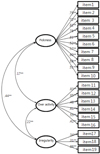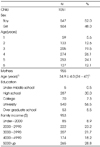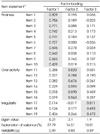Abstract
Objectives
This study was conducted to develop and validate Eating Behaviors Test form (EBT) for infants and young children, including eating behaviors of their parents and parental feeding practices.
Methods
Draft version of EBT form was developed after a pretest on 83 mothers. It was consisted of 42 questions including 3 components; eating behavior of children, eating behavior of parents, and parental feeding practices. Using these questionnaires, the first survey was conducted on 320 infants and children, 1 to 6 year old, for exploratory factor analysis, and the second survey was collected on 731 infants and children for confirmatory factor analysis.
Results
Exploratory factor analysis on 42 questions of EBT form resulted in 3 factor model for children's eating behavior, 3 factor model for parents' eating behavior, and 1 factor model for parental feeding practices. Three factors for children's eating behavior could be explained as follows; factor 1, pickiness (reliability α=0.89; explanation of variance=27.79), factor 2, over activity (α=0.80, explanation of variance=16.51), and factor 3, irregularity (α=0.59, explanation of variance=10.01). Three factors for mother's eating behavior could be explained as follows; factor 1,irregularities (α=0.73, explanation of variance=21.73), factor 2, pickiness (α=0.65, explanation of variance= 20.16), and factor 3, permissiveness (α=0.60, explanation of variance=19.13). Confirmatory factor analysis confirmed an acceptance fit for these models. Internal consistencies for these factors were above 0.6.
Figures and Tables
References
1. Baek KS. A study on children's adjustment to full-time daycare center. Doctorate Thesis. Sookmyung Women's University;1996.
2. Bentler PM. Comparative fit indexes in structural models. Psychol Bull. 1990; 107(2):238–246.
3. Birch LL, Fisher JO. Development of eating behaviors among children and adolescents. Pediatrics. 1998; 101(3 Pt 2):539–549.
4. Blissett J, Fogel A. Intrinsic and extrinsic influences on children's acceptance of new foods. Physiol Behav. 2013; 121:89–95.
5. Chatoor I, Ganiban J, Hirsch R, Borman-Spurrell E, Mrazek DA. Maternal characteristics and toddler temperament in infantile anorexia. J Am Acad Child Adolesc Psychiatry. 2000; 39(6):743–751.
6. Chess S, Thomas A. Temperamental individuality from childhood to adolescence. J Am Acad Child Psychiatry. 1977; 16(2):218–226.
7. Dunn W. The impact of sensory processing abilities on the daily lives of young children and their families: a conceptual model. Infants Young Child. 1997; 9(4):23–35.
8. Farrow CV, Coulthard H. Relationships between sensory sensitivity, anxiety and selective eating in children. Appetite. 2012; 58(3):842–846.
9. Fullard W, McDevitt SC, Carey WB. The relationship between parental literacy level and perception of emergent literacy. J Read Behav. 1984; 23(2):191–213.
10. Gibson EL, Wardle J, Watts CJ. Fruit and vegetable consumption, nutritional knowledge and beliefs in mothers and children. Appetite. 1998; 31(2):205–228.
11. Hagekull B, Bohlin G, Rydell AM. Maternal sensitivity, infant temperament, and the development of early feeding problems. Infant Ment Health J. 1997; 18(1):92–106.
12. Harper LV, Sanders KM. The effect of adults' eating on young children's acceptance of unfamiliar foods. J Exp Child Psychol. 1975; 20(2):206–214.
13. Hendy HM, Raudenbush B. Effectiveness of teacher modeling to encourage food acceptance in preschool children. Appetite. 2000; 34(1):61–76.
14. Hetherington MM, Schwartz C, Madrelle J, Croden F, Nekitsing C, Vereijken CM, Weenen H. A step-by-step introduction to vegetables at the beginning of complementary feeding. The effects of early and repeated exposure. Appetite. 2015; 84:280–290.
15. Johnson SL, Birch LL. Parents' and children's adiposity and eating style. Pediatrics. 1994; 94(5):653–661.
16. Kim Y, Han Y, Chung S, Lee Y, Lee S, Choi H. Characteristics of infants' temperaments and eating behaviors, mothers' eating behaviors and feeding practices in poor eating infants. Korean J Community Nutr. 2006; 11(4):449–458.
17. Kim YJ, Chung S, Han Y, Lee Y, Lee S, Byun K, Choi H. The characteristics of infants' temperament, maternal feeding behavior and feeding practices in picky eaters. Korean J Community Nutr. 2005; 10(4):462–470.
18. Kwon SH. Multivariate data analysis-using SPSS. Daejeon: Hannam University Press;2005.
19. Lee MS. The effects of temperament and peer-support on the self-evaluation of early adolescents. Dissertation. Yonsei University;1994.
20. Moding KJ, Birch LL, Stifter CA. Infant temperament and feeding history predict infants' responses to novel foods. Appetite. 2014; 83:218–225.
21. Morrison H, Power TG, Nicklas T, Hughes SO. Exploring the effects of maternal eating patterns on maternal feeding and child eating. Appetite. 2013; 63:77–83.
22. Pliner P, Hobden K. Development of a scale to measure the trait of food neophobia in humans. Appetite. 1992; 19(2):105–120.
23. Pliner P, Loewen ER. Temperament and food neophobia in children and their mothers. Appetite. 1997; 28(3):239–254.
24. Putnam SP, Gartstein MA, Rothbart MK. Measurement of fine-grained aspects of toddler temperament: the early childhood behavior questionnaire. Infant Behav Dev. 2006; 29(3):386–401.
25. Rollins BY, Loken E, Savage JS, Birch LL. Effects of restriction on children's intake differ by child temperament, food reinforcement, and parent's chronic use of restriction. Appetite. 2014; 73:31–39.
26. Saslow ER. Temperament and day care: an examination of differences in expression across settings. Dissertation. Temple University;1993.
27. Steiger JH. Structural model evaluation and modification: aninterval estimation approach. Multivariate Behav Res. 1990; 25(2):173–180.
28. Stunkard AJ, Messick S. The three-factor eating questionnaire to measure dietary restraint, disinhibition and hunger. J Psychosom Res. 1985; 29(1):71–83.
29. Sullivan SA, Birch LL. Infant dietary experience and acceptance of solid foods. Pediatrics. 1994; 93(2):271–277.
30. Windle M. Temperament and social support in adolescence: interrelations with depressive symptoms and delinquent behaviors. J Youth Adolesc. 1992; 21(1):1–21.
31. Wright DE, Radcliffe JD. Parents' perceptions of influences on food behavior development of children attending day care facilities. J Nutr Educ. 1992; 24(4):198–201.
32. Yang BH. Understanding multivariate data analysis. Seoul: Communication Books;2006.




 PDF
PDF ePub
ePub Citation
Citation Print
Print










 XML Download
XML Download